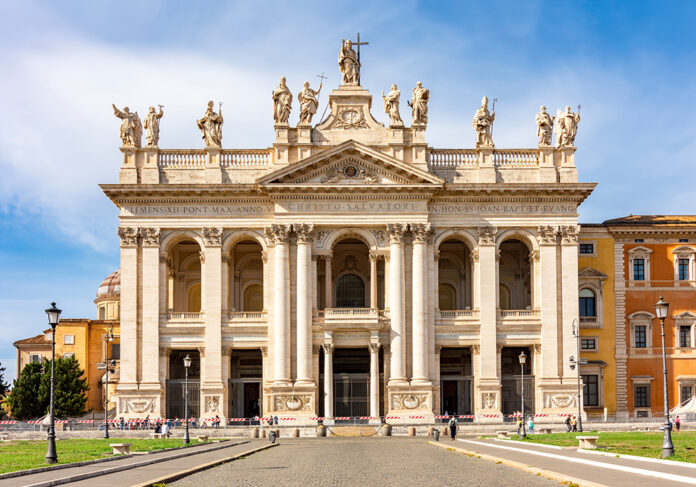Today is the feast of the dedication of St. John Lateran which is the Basilica in Rome where the Cathedral seat for the Bishop of Rome, or the Pope, resides. It is a feast in which we keep in mind the beauty of the institutional structure of our Church, and celebrate the authority by which the Church guides us. Today is also a celebration of the distinct gift of being able to gather and worship God in a specific space in time. The readings for today reflect this reality and focus on the heart of worship which is less about the exterior, such as place and ritual (although that is important), and more about the interior disposition of a person.
In the first reading while he is in exile from the land of Judah, Ezekiel is given a vision of the temple. He notes that the temple is facing east, and from it comes a river that gives life wherever it flows. In the Gospel we hear the famous story of Jesus cleansing the temple by setting the animals loose and flipping over tables which shocks the Jews. Both of these stories are bringing to light the insufficiency of the old temples of the Jews and are pointing to the true place of worship: the new temple.
In the time of Ezekiel, the old temple of Solomon had failed. Despite all of its glory and beauty, the people only followed God only with the lips and not their heart. They desired to worship false gods like the other nations around them, and they often did. As a result, God left them to their own devices and allowed them to be conquered by foreign nations who destroyed the temple to the despair of the Jews.
At the time of Jesus, about six hundred years later, a second temple had been erected. Although it was not as grand as Solomon’s temple, it was still a magnificent structure. But once again, while the rituals of the Jewish people became very rigid in some cases so as not to break the letter of the Mosaic Law, the people did not worship God in their heart. They checked the box of ritualistic worship in order to chase their own vain pursuits which usually involved amassing money. So in both instances of the first and second temple, the people have a place to worship, but it gets profaned by insincere hearts and idol worship.
When Jesus cleanses the temple, many believe that He does this the same week that He dies. This means that it is one of His last actions that may have been a catalyst for the Jews pursuing His execution. But what is Jesus trying to say with this important prophetic act?
First, I would like to posit that Jesus only resorts to physical violence, because it is a last ditch attempt to get the leaders in the temple to listen to Him. He had been preaching, teaching, and healing for years, but they had ignored Him. In fact, many openly opposed Him. So He uses His righteous zeal to send a message, which is heard, but not received well.
Second, and most importantly, Jesus is trying to teach them the key to correct worship. It is not meant to be a slavery to external laws and regulations in which the focus is doing the exact right actions. Rather, it is the interior that needs to be cultivated. The source of worship is love for the Creator who Jesus teaches us is our Heavenly Father. And while our actions should reflect this love, they are not restricted to one uniform ritual. When an over attachment to rules and regulations does happen, as is human nature, we have a tendency to manipulate them to benefit ourselves which is the exact opposite of what worship is meant to be: Love through sacrifice.
Just like the Jews of the past, we inevitably all fail when it comes to giving God pure worship. Our tendency to sin and self preservation prevents us from having great love which is laying down our entire lives for God and others. The only person who was able to humble Himself, even to the point of death on the cross and resist sin even to the point of shedding His blood was Jesus. He was able to do this, not because He frequented the temple and performed all of the Jewish rituals to the letter of the Law, but because interiorly, He had a love for His Heavenly Father that drove His actions.
Consequently, the new temple of worship is Jesus’ body – which is what Jesus subtly reveals to the Jews when He gives a sign for His zeal in the old temple. His body is the only physical apparatus in time and space that has worshiped God fully in Spirit and in Truth. So it is only in Him that we can truly worship. This is why the image of the new temple in Ezekiel has the river flowing from it. These are the waters of baptism that flow from the side of the new temple (Jesus) that give life to all who remain in Him. Jesus has given us this ability by entering His body (the Church) to receive Him (in the sacraments) so that the new temple of worship can be our bodies that are filled with the Holy Spirit. This means that our worship comes from our interior love for God because Jesus enables us to have this love.
So as the Catholic world celebrates this great feast but also rages in its liturgy wars, let us remember that the exterior rituals are important and can lead us to good worship, but true worship comes from the interior love of God that is inspired by the Holy Spirit. If we want to love our Father well, we need to act as Jesus would, which is accepting the will of the Father in the act of submission and love so that we can say as He did: Thy will be done.






